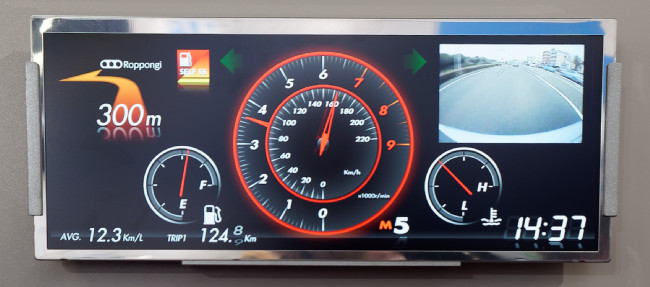Mitsubishi had plenty of news at the event, as it has most years when it shows its range of industrial displays at this event.
First we had a look at a range of transflective displays, available in 5.7″, 8.4″ (production) and 10.4″ (under development) sizes that can run in high ambient light. Brightness is 500, 300 and 350 cd/m², respectively and the displays can be run in transmissive mode at night, but in reflective mode in sunshine, to exploit the natural light and minimise power consumption. The smaller displays have VGA resolution, but this goes up to 1024 x 768 on the 10.4″. Staff told us that the 8.4″ uses only 6.4W, even when it is running with the backlight on in transmissive mode. Reflectivity is around the 9% -10% level.
Mitsubishi is now quoting lifetimes of 100,000 hours for many of its industrial displays. Furthermore, operating conditions can go down to -30º C and up to 80º C in the regular range.
Next we looked at a new 10.4″ SVGA display that has 800 x 600 resolution, but has 1,500 cd/m² of output with 1,000:1 contrast. This has an anti-reflective polariser and is optically bonded for optimum performance in bright conditions. The display is in the ‘Toughness’ series and that means that it can survive 6.8g shock as well as extending the range of temperatures from -40º C to +85º C. The display is available with a range of brightnesses down to 600 cd/m² and now uses an IPS panel, whereas earlier models used TN. The display is also available in 800 x 600 or 1024 x 768 resolution and with resistive touch integrated, but this limits the range of temperatures that is supported.
Mitsubishi has developed its PCap solutions. Earlier, these were just two touch, as that was considered enough for industrial applications, but this has now been extended to 10 touch with optical bonding. There has been a challenge to get good signal to noise performance with bonded PCap solutions, as the air gap is a help with blocking noise. When the OCA is put in, the noise from the LCD driving tends to get worse. Mitsubishi uses its own sensor and controller board to achieve a good result.
There are two Mitsubishi 15 inch industrial displays that are the same apart from the resolution. XGA is on the left, 1400 x 1050 on the right. Image:Meko
Another new panel was a 15″ with XGA+ resolution – 1400 x 1050 that has the same fit and form as the existing 1024 x 768 display and is helping Mitsubishi to respond to a desire for higher resolutions. The 15″ is available with 1,000 cd/m².
We’re used to reporting ‘stretch’ displays in large sizes, but Mitsubishi has developed a 19.2″ display which is 1/3 height and has 1920 x 360 resolution (16:3 aspect ratio). The display has 500 cd/m² of output and 700:1 contrast, and is based on TN technology. The panel is made this size natively, rather than being ‘cut’ from a standard panel. There is also a 7.8″ half SVGA display with 800 x 300 resolution and 500 cd/m² of luminance and 1,000:1 contrast. These panels are available in portrait modes, but the portrait version is different from the landscape model, as the polariser is rotated to avoid problems when the display is viewed by someone wearing polarising sunglasses.
 Mitsubishi’s automotive 12.3″ LCD is popular. Image:Meko
Mitsubishi’s automotive 12.3″ LCD is popular. Image:Meko
Finally, we looked at 10.3″, 12.3″ (1920 x 720) and 15″ displays that Mitsubishi is selling for automotive applications. The uniformity is said to be particularly good and the backlights support a wide dimming range so that they still work well at night. The company is looking at more sophisticated backlight dimming as the request from automotive companies is for very good blacks. At the request of clients, the firm is looking at developing curved displays for automotive applications.

